Electricity becomes a commodity. The first power plants
Power plants, which are understood by the factories for the production of electrical energy, which is subject to distribution among different consumers, did not appear immediately. In the 70's and early 80's of the last century, the place of electricity production was not separated from the place of consumption.
Electric stations that provided electricity to a limited number of consumers were called block stations (not to be confused with the modern notion of block stations, which some authors understand as factory-built combined heat and power plants). Such stations were sometimes called "house".
In connection with the difficulties in adjusting the arc lighting system, specialized block stations were built at first: one for arc lamps, the other for incandescent lamps. Sometimes on the same station the generators were divided into two corresponding groups.
The development of the first power plants was associated with overcoming difficulties not only of a scientific and technical nature. So, the city authorities forbade the construction of overhead lines, not wanting to spoil the appearance of the city. Competing gas companies in every way emphasized the actual and imaginary shortcomings of the new type of lighting.
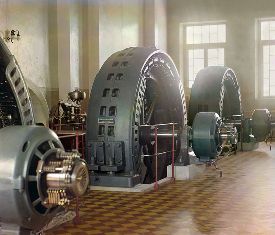
At electric block stations, built in the late 70's and early 80's of the last century, mainly piston steam engines were used as primary engines. In some cases, internal combustion engines were used, at the time being a novelty. To cheapen the steam-power part of the block stations, locomobiles were widely used. A belt drive was made from the primary engine to the electric generator, which made it possible to drive high-speed electric generators from comparatively slow-moving steam engines having a speed of no more than 200 rpm.
For the first time, station stations were built in Paris to illuminate the Opera Street. In Russia, the first installation of this kind was the station for lighting the Foundry Bridge in St. Petersburg, created in 1879 with the participation of PN Yablochkov. From the end of 1881 there are block stations, in the network of which both arc lamps and incandescent lamps were switched on.
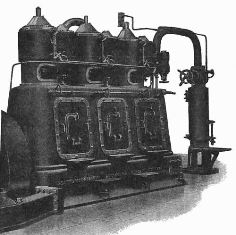
However, the idea of a centralized electricity production was so economically justified and so consistent with the trend of concentration of industrial production that the first central power plants arose already in the mid-1980s and quickly replaced the block stations. Due to the fact that in the early 80s, only light sources could become mass consumers of electricity, the first central power plants were designed as a rule to power the lighting load and produce a direct current.
In 1881, several enterprising American financiers under the impression of success, which was accompanied by the demonstration of incandescent lamps, concluded an agreement with Edison and began construction of the world's first central power station (on Pearl Street in New York). In September 1882, this power plant was put into operation.
In the engine room of the station, six Edison generators were installed. The power of each generator was about 90 kW, and the total power of the power plant exceeded 500 kW. The station building and its equipment were designed very expediently, so in the future when building new power plants, many of the principles that were proposed by Edison developed.
Thus, the station generators had artificial cooling and connected directly to the engine. Voltage was adjusted automatically. At the station, a mechanical supply of fuel to the boiler room and automatic removal of ash and slag were carried out. The equipment was protected against short-circuit currents by fuses, and the trunk lines were cable fuses. The station supplied electricity to an extensive 2.5 km area at that time. Soon in New York, several more stations were built.
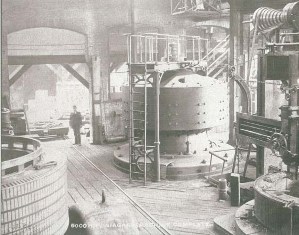
The initial voltage of the first power plants, from which the others were subsequently produced, forming a known stress scale, developed historically.
The fact is that in the period of the exclusive propagation of electric arc illumination it was empirically established that the most suitable for arc burning is the voltage of 45 V. To reduce the short-circuit currents that arose at the moment of ignition of the lamps (upon contact of coals) and for more stable combustion The arcs consisted of a ballast resistor in series with the arc lamp.
It was also found empirically that the resistance of the ballast resistor should be such that the voltage drop across it during normal operation was approximately 20 V. Thus, the total voltage in the DC installations was initially 65 V, and this voltage was used for a long time. However, two arc lamps consistently consisted of two arc lamps in series, requiring 2 x 45 = 90 V for operation, and if this voltage was increased by another 20 V, the resistance of the ballast resistor would be 110 V. This voltage was almost universally accepted As a standard, and it is this that opens up a modern stress scale, although the reason for choosing has long been forgotten.
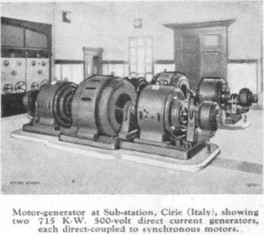
Even when designing the first central power plants, they encountered difficulties that were not sufficiently overcome during the entire period of domination of DC technology. The power supply radius is determined by permissible voltage losses in the electric network, which for a given network are less, the higher the voltage. These circumstances made it necessary to build power plants in the central districts of the city, which made it difficult not only to provide water and fuel, but also increased the cost of land for the construction of stations, as the land in the center of the city was extremely expensive. This in particular explains the unusual appearance of New York stations, on which the equipment was located on many floors.
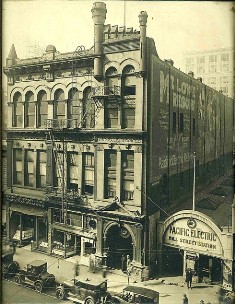
The situation was further complicated by the fact that the first power plants had to place a large number of boilers whose steam production capacity did not meet the new requirements set by the electric power industry.
No less surprised would be our contemporary, seeing the first St. Petersburg power stations that served the Nevsky Prospekt area. In the early 80's they were placed on barges fixed at the piers on the Moika and Fontanka rivers.
Builders proceeded from considerations of cheap water supply, in addition, with this decision it was not necessary to buy land plots close to the consumer.
In 1886 in St. Petersburg, the joint-stock company Electric Lighting Society of 1886 was established (abbreviated as "Society of 1886"), which acquired stations on the Moika and Fontanka rivers and built two more: near the Kazan Cathedral and on the Engineering Square. The power of each of these stations hardly exceeded 200 kW.
In Moscow, the first central power station (Georgievskaya) was built in 1886, too, in the city center, at the corner of Bolshaya Dmitrovka (now Pushkinskaya Street) and Georgievsky Lane. Its energy was used to illuminate the surrounding area. The power of the station was 400 kW.
The limited possibilities for expanding the electric power supply radius have made it more difficult to meet the demand for electricity over time. For example, in St. Petersburg and Moscow, by the mid-1990s, the possibility of adding a new load to existing stations was exhausted and the question arose of changing network schemes or even of changing the type of current.
At the central stations, with increasing capacity, the locomobiles used as the primary engines of the block stations were gradually replaced by stationary machines. The power of their machines was 100-300 hp, the speed of the shaft was relatively small (100-200 rpm), which led to the need to introduce a belt or cable transmission between the machine and the generator.
In the boiler room of the early thermal power plants, fire-tube boilers were installed, but soon, in connection with the increase in power, boilers of higher steam production were needed - water-tube boilers. In the late XIX and early XX centuries. The preferred distribution in boilers of foreign power plants was the Babcock-Wilcox boilers, and in Russia - the boilers of the Shukhov system.
The main fuel of boiler rooms with manual loading was coal, burned on flat grates. The consumption of coal with this method of incineration and the absence of economizers, heating the air and with poor insulation was 3-4 times higher than that of modern stations.
The growing demand for electricity has effectively stimulated the increase in efficiency and economy of the thermal part of the power plants. First of all, we should note a decisive turn from piston steam engines to steam turbines. The first steam turbine at Russia's power plants was installed in 1891 in St. Petersburg (station on the Fontanka River). A year before, the turbine was tested at a station located on the Moika River.
During the period under review, hydroelectric power stations were built rarely due to the difficulties of transmitting electricity over long distances. We have already noted the most significant shortage of DC power supply - too small an area that can be serviced by a central power plant. The distance to the load did not exceed several hundred meters.
Power plants - enterprises sought to expand the circle of consumers of their goods - electricity. This explains the persistent search for ways to increase the area of electricity supply, provided that the already existing DC stations are preserved. Several ways of increasing the radius of energy distribution have been found.
The first idea, which did not receive a noticeable spread, concerned the lowering of the voltage of electric bulbs connected at the end of the line. However, calculations showed that with a network length of more than 1.5 km it was economically more profitable to build a new power plant.
Another solution that could in many cases satisfy the need was to change the network layout, the transition from two-wire networks to multi-wire networks, i.e. In fact to increase the voltage.
A three-wire distribution system was proposed in 1882 by J. Hongkpson and independently by T. Edison. Under this system, the generators in the power plant were connected in series and a neutral or compensating wire walked from the common point. In this case, the usual lamps were saved. They were switched on as a rule between workers and neutral wires, and the motors for keeping the load symmetry could be switched on to high voltage (220 V).
If the loads in both branches of the three-wire system were the same, there was no current in the neutral wire. In other cases, a current appeared in the neutral wire, which was usually much less than the operating current. The latter circumstance made it possible to choose the cross section of the neutral wire smaller (usually 1/2: or 1/3 of the cross section of the working wire).
It should not be overlooked that the cross section of the working wires also decreased in this case in comparison with the cross section of the wires in the two-wire system. This was explained by the fact that when the voltage was doubled, the current decreased by a factor of two when power was doubled, and the losses proportional to the square of the current decreased fourfold. The practical results of the introduction of the three-wire system was, first, an increase in the power supply radius to about 1200 m, and secondly, the relative economy of copper (under all other identical conditions, the copper consumption for a three-wire system was almost half that of a two-wire system).
To regulate the voltage in the branches of the three-wire network, various devices were used: adjusting additional generators, voltage dividers, in particular the widely distributed voltage dividers Dolivo-Dobrovolsky, storage batteries. The three-wire system was widely used both in Russia and abroad. It survived until the 1920s, and in some cases was later applied.
The maximum version of multi-wire systems is a five-wire DC network, in which four series-connected generators were used and the voltage increased fourfold. The radius of power supply increased to 1500 m. However, a relatively small increase in the power supply radius was achieved in this case due to a significant complication of the network, increasing the voltage to dangerous limits, complicating the regulation of the uniformity of the load of individual branches. Therefore, the five-wire system was not widely used, although its author V. Siemens believed that the five-wire system would compete successfully with AC systems.
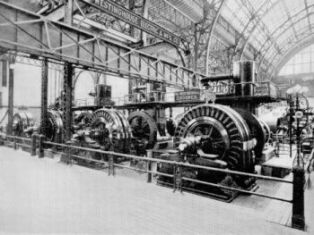
The third way to increase the radius of power supply assumed the construction of battery substations. Rechargeable batteries were at that time an indispensable addition to each power plant. They covered the peaks of loads. Charging in the afternoon and late at night, they served as a reserve. Rechargeable batteries are the same as in modern power plants (where, however, these batteries perform other functions - power management, protection, automation and emergency lighting), located in special large rooms.
To increase the power supply radius, the batteries were installed at substations in two-wire DC networks. These substations were built near individual consumers. The groups of batteries, connected in series, were charged from the central station at double voltage, and with parallel connection they fed local load.
Networks with battery substations have received some distribution. In Moscow, for example, was built in 1892, a battery substation in the Upper Trading Rows (now GUM), located at a distance of 1385 meters from St. George's central station. At this substation, batteries were installed, feeding about 2000 incandescent lamps.
In the last two decades of the last century, many DC power plants were built, and for a long time they provided a significant share of the total power generation. The power of such power plants rarely exceeded 500 kW, the units usually had a power of up to 100 kW.
All the possibilities of increasing the radius of power supply at a constant current were quickly exhausted. Multiple-wire networks and networks with battery substations could still meet the needs of small and medium-sized cities, but they did not meet the needs of a large city at all.
In the 1980s, AC stations were starting to be built, whose profitability from the point of view of increasing the electrical supply radius was unquestionable.
Except for the AC-block stations built in England in 1882-1883, when the transformers of Golar and Gibbs appeared, the station of the Grove Gallery (London) seems to be the first permanent AC power station.
At this station, put into operation in 1884, two Siemens alternating current generators were installed, which, through the series-switched transformers of Golard and Gibbs, operated to illuminate the gallery. The shortcomings of the sequential inclusion of transformers and, in particular, the difficulty of maintaining the constancy of the current, were detected quite quickly, and in 1886 this station was reconstructed according to the design of S.C. Ferranti. Siemens generators were replaced by Ferranti machines each with a power of 1000 kW with a voltage of 2.5 kV. Transformers manufactured according to the Ferranti project were connected in a parallel circuit and served to reduce the voltage in the immediate vicinity of consumers.
In the years 1889-1890. Ferranti returned to the problem of electricity supply in London. This time, the task was to provide electricity to the entire area of the City of London. But since the company that financed the work did not agree to pay for the high cost of the land in the city center, Ferranti chose a place for a new central power station in one of the suburbs of London, in Dentford, 12 km from the City.
To build a power plant at such a large distance from the place of consumption of electricity could only be provided that it will produce alternating current.
During the construction of this installation, high-voltage machines of the time were used. Generators with a capacity of 1000 hp were installed. With a voltage of 10 kV, and unlike the old generators, which were driven from the steam engine by wire rope, new generators were directly connected to high-speed vertical steam engines.
The frequency of rotation of the shaft of steam piston engines also lagged far behind the normal speed of electric generators. This in particular explains the peculiar design of the electrical generator of that time, they had large diameters and small lengths. The same relations in general between the diameter and length of the machine have been preserved at the present time at hydrostations with relatively low-speed water armholes as the primary engine. The total power of the Dentford station was about 3000 kW.
At four city substations that fed on four trunk cable lines, the voltage was reduced to 2400 V), and then the consumers (in homes) had the voltage lowered to 100 V.
An example of a large single-phase power station that fed the lighting load could be a station built in 1889 on a waterfall near Portland (USA). At this station, hydraulic motors powered eight single-phase generators with a total power of 720 kW. In addition, 11 generators designed specifically for feeding arc lamps (100 lamps per generator) were installed at the station. The energy of this station was transmitted 14 miles to Portland.
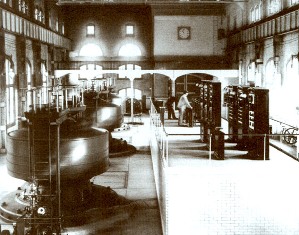
A characteristic feature of the first AC power plant is the isolated operation of individual machines. Synchronization of the generators has not yet been carried out and each machine has a separate chain to consumers. It is easy to understand how uneconomical under these conditions were electrical networks, the construction of which consumed colossal amounts of copper and insulators.
In Russia, the largest single-phase current stations were built in the late 80's and early 90's. The first central power plant was built by the Hungarian firm Ganz and Co. in Odessa in 1887. The main electricity consumer was the electric lighting system of the new theater.
This power plant was a progressive construction for its time. It had 4 water-tube boilers with a total capacity of 5 tons of steam per hour, as well as two synchronous generators with a total output of 160 kW at a voltage of 2 kV and a frequency of 50 Hz. From the distribution bus, energy entered a line 2.5 km long, leading to the transformer substation of the theater, where the voltage dropped. The power plant equipment was so perfect for its time that, despite the fact that British coal was imported, the cost of electricity was lower than in later St. Petersburg and Moscow power plants. The fuel consumption was .1.4 kg / kWh (at St. Petersburg power plants - 3.9-5.4 kg / kWh).
In the same year, the operation of a DC power plant in Tsarskoe Selo (nowadays Pushkin) began. The length of the air network in Tsarskoe Selo in 1887 was about 64 km, while two years later the total cable network of the "Society of 1886" in Moscow and St. Petersburg was only 115 km. In 1890 Tsarskoselskaya station and the network were reconstructed and transferred to a single-phase alternating current of 2 kV. According to contemporaries, Tsarskoe Selo was the first city in Europe, which was illuminated exclusively by electricity.
The largest single-phase power station in Russia was a station on Vasilievsky Island in St. Petersburg, built in 1894 by engineer NV Smirnov. Its power was 800 kW and exceeded the power of any existing DC station at that time. As the primary engines, four vertical steam engines with a capacity of 250 hp were used. Each. The use of an alternating current of 2000 V made it possible to simplify and reduce the cost of the electric network and to increase the power supply radius (more than 2 km with a loss of up to 3% of the voltage in the main wires instead of 17-20% in DC networks).
Thus, the experience of operation of central stations and single-phase current networks showed the advantages of alternating current, but at the same time, as already noted, revealed its limited application. Single-phase system inhibited the development of the electric drive, complicated it. So, for example, when connecting the power load to the network of the Deptford station, it was necessary to additionally prevent an even accelerating commutator motor of an alternating current on the shaft of each synchronous single-phase motor. It is easy to understand that such a complication of the electric drive made doubtful the possibility of its wide application.
Veselovsky ON Shneyberg Ya. A. Essays on the History of Electrical Engineering


Comments
When commenting on, remember that the content and tone of your message can hurt the feelings of real people, show respect and tolerance to your interlocutors even if you do not share their opinion, your behavior in the conditions of freedom of expression and anonymity provided by the Internet, changes Not only virtual, but also the real world. All comments are hidden from the index, spam is controlled.